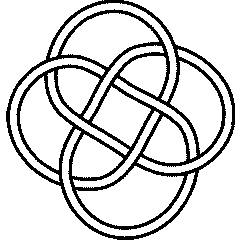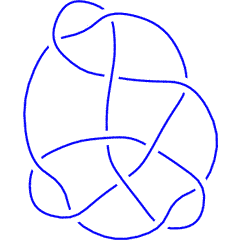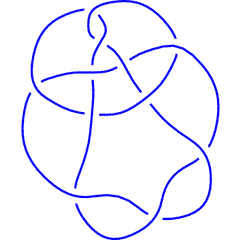The Alexander-Conway Polynomial: Difference between revisions
No edit summary |
No edit summary |
||
| (15 intermediate revisions by 9 users not shown) | |||
| Line 5: | Line 5: | ||
<!--$$?Alexander$$--> |
<!--$$?Alexander$$--> |
||
<!--Robot Land, no human edits to "END"--> |
<!--Robot Land, no human edits to "END"--> |
||
{{HelpAndAbout| |
|||
{{HelpAndAbout1|n=1|s=Alexander}} |
|||
n = 2 | |
|||
| ⚫ | |||
n1 = 3 | |
|||
{{HelpAndAbout2|n=2|s=Alexander}} |
|||
in = <nowiki>Alexander</nowiki> | |
|||
| ⚫ | |||
| ⚫ | |||
{{HelpAndAbout3}} |
|||
| ⚫ | |||
<!--END--> |
<!--END--> |
||
<!--$$?Conway$$--> |
<!--$$?Conway$$--> |
||
<!--Robot Land, no human edits to "END"--> |
<!--Robot Land, no human edits to "END"--> |
||
{{HelpLine| |
|||
{{Help1|n=3|s=Conway}} |
|||
n = 4 | |
|||
| ⚫ | |||
in = <nowiki>Conway</nowiki> | |
|||
{{Help2}} |
|||
| ⚫ | |||
<!--END--> |
<!--END--> |
||
{{Knot Image|8_18}} |
{{Knot Image|8_18|gif}} |
||
The Alexander polynomial <math>A(K)</math> and the Conway polynomial <math>C(K)</math> of a knot <math>K</math> always satisfy <math>A(K)(t)=C(K)(\sqrt{t}-1/\sqrt{t})</math>. Let us verify this relation for the knot [[8_18]]: |
The Alexander polynomial <math>A(K)</math> and the Conway polynomial <math>C(K)</math> of a knot <math>K</math> always satisfy <math>A(K)(t)=C(K)(\sqrt{t}-1/\sqrt{t})</math>. Let us verify this relation for the knot [[8_18]]: |
||
| Line 25: | Line 27: | ||
<!--$$alex = Alexander[Knot[8, 18]][t]$$--> |
<!--$$alex = Alexander[Knot[8, 18]][t]$$--> |
||
<!--Robot Land, no human edits to "END"--> |
<!--Robot Land, no human edits to "END"--> |
||
{{ |
{{InOut| |
||
n = 5 | |
|||
in = <nowiki>alex = Alexander[Knot[8, 18]][t]</nowiki> | |
|||
out= <nowiki> -3 5 10 2 3 |
|||
13 - t + -- - -- - 10 t + 5 t - t |
13 - t + -- - -- - 10 t + 5 t - t |
||
2 t |
2 t |
||
t</nowiki> |
t</nowiki>}} |
||
{{InOut3}} |
|||
<!--END--> |
<!--END--> |
||
<!--$$Expand[Conway[Knot[8, 18]][Sqrt[t] - 1/Sqrt[t]]]$$--> |
<!--$$Expand[Conway[Knot[8, 18]][Sqrt[t] - 1/Sqrt[t]]]$$--> |
||
<!--Robot Land, no human edits to "END"--> |
<!--Robot Land, no human edits to "END"--> |
||
{{ |
{{InOut| |
||
n = 6 | |
|||
in = <nowiki>Expand[Conway[Knot[8, 18]][Sqrt[t] - 1/Sqrt[t]]]</nowiki> | |
|||
out= <nowiki> -3 5 10 2 3 |
|||
13 - t + -- - -- - 10 t + 5 t - t |
13 - t + -- - -- - 10 t + 5 t - t |
||
2 t |
2 t |
||
t</nowiki> |
t</nowiki>}} |
||
{{InOut3}} |
|||
<!--END--> |
<!--END--> |
||
| Line 49: | Line 51: | ||
<!--$$Abs[alex /. t -> -1]$$--> |
<!--$$Abs[alex /. t -> -1]$$--> |
||
<!--Robot Land, no human edits to "END"--> |
<!--Robot Land, no human edits to "END"--> |
||
{{ |
{{InOut| |
||
n = 7 | |
|||
in = <nowiki>Abs[alex /. t -> -1]</nowiki> | |
|||
{{InOut2|n=6}}<pre style="border: 0px; padding: 0em"><nowiki>45</nowiki></pre> |
|||
out= <nowiki>45</nowiki>}} |
|||
{{InOut3}} |
|||
<!--END--> |
<!--END--> |
||
| Line 59: | Line 61: | ||
<!--$$KnotDet[Knot[8, 18]]$$--> |
<!--$$KnotDet[Knot[8, 18]]$$--> |
||
<!--Robot Land, no human edits to "END"--> |
<!--Robot Land, no human edits to "END"--> |
||
{{ |
{{InOut| |
||
n = 8 | |
|||
<pre style="color: red; border: 0px; padding: 0em"><nowiki>KnotDet[Knot[8, 18]]</nowiki></pre> |
|||
in = <nowiki>KnotDet[Knot[8, 18]]</nowiki> | |
|||
out= <nowiki>45</nowiki>}} |
|||
{{InOut3}} |
|||
<!--END--> |
<!--END--> |
||
| Line 69: | Line 71: | ||
<!--$$Coefficient[Conway[Knot[8, 18]][z], z^2]$$--> |
<!--$$Coefficient[Conway[Knot[8, 18]][z], z^2]$$--> |
||
<!--Robot Land, no human edits to "END"--> |
<!--Robot Land, no human edits to "END"--> |
||
{{ |
{{InOut| |
||
n = 9 | |
|||
in = <nowiki>Coefficient[Conway[Knot[8, 18]][z], z^2]</nowiki> | |
|||
{{InOut2|n=8}}<pre style="border: 0px; padding: 0em"><nowiki>1</nowiki></pre> |
|||
out= <nowiki>1</nowiki>}} |
|||
{{InOut3}} |
|||
<!--END--> |
<!--END--> |
||
| Line 79: | Line 81: | ||
<!--$$Vassiliev[2][Knot[8, 18]]$$--> |
<!--$$Vassiliev[2][Knot[8, 18]]$$--> |
||
<!--Robot Land, no human edits to "END"--> |
<!--Robot Land, no human edits to "END"--> |
||
{{ |
{{InOut| |
||
n = 10 | |
|||
in = <nowiki>Vassiliev[2][Knot[8, 18]]</nowiki> | |
|||
{{InOut2|n=9}}<pre style="border: 0px; padding: 0em"><nowiki>0</nowiki></pre> |
|||
out= <nowiki>1</nowiki>}} |
|||
{{InOut3}} |
|||
<!--END--> |
<!--END--> |
||
{{Knot Image Pair|K11a99|gif|K11a277|gif}} |
|||
Sometimes two knots have the same Alexander polynomial but different Alexander ideals. An example is the pair [[K11a99]] and [[K11a277]]. They have the same Alexander polynomial, but the second Alexander ideal of the first knot is the whole ring <math>{\mathbb Z}[t]</math> while the second Alexander ideal of the second knot is the smaller ideal generated by <math>3</math> and by <math>1+t</math>: |
Sometimes two knots have the same Alexander polynomial but different Alexander ideals. An example is the pair [[K11a99]] and [[K11a277]]. They have the same Alexander polynomial, but the second Alexander ideal of the first knot is the whole ring <math>{\mathbb Z}[t]</math> while the second Alexander ideal of the second knot is the smaller ideal generated by <math>3</math> and by <math>1+t</math>: |
||
| Line 89: | Line 93: | ||
<!--$${K1, K2} = {Knot[11, Alternating, 99], Knot[11, Alternating, 277]};$$--> |
<!--$${K1, K2} = {Knot[11, Alternating, 99], Knot[11, Alternating, 277]};$$--> |
||
<!--Robot Land, no human edits to "END"--> |
<!--Robot Land, no human edits to "END"--> |
||
{{ |
{{In| |
||
n = 11 | |
|||
in = <nowiki>{K1, K2} = {Knot[11, Alternating, 99], Knot[11, Alternating, 277]};</nowiki>}} |
|||
{{In2}} |
|||
<!--END--> |
<!--END--> |
||
<!--$$Alexander[K1] == Alexander[K2]$$--> |
<!--$$Alexander[K1] == Alexander[K2]$$--> |
||
<!--Robot Land, no human edits to "END"--> |
<!--Robot Land, no human edits to "END"--> |
||
{{InOut| |
|||
{{InOut1|n=11}} |
|||
n = 12 | |
|||
in = <nowiki>Alexander[K1] == Alexander[K2]</nowiki> | |
|||
{{InOut2|n=11}}<pre style="border: 0px; padding: 0em"><nowiki>True</nowiki></pre> |
|||
out= <nowiki>True</nowiki>}} |
|||
{{InOut3}} |
|||
<!--END--> |
<!--END--> |
||
<!--$$Alexander[K1, 2][t]$$--> |
<!--$$Alexander[K1, 2][t]$$--> |
||
<!--Robot Land, no human edits to "END"--> |
<!--Robot Land, no human edits to "END"--> |
||
{{InOut| |
|||
{{InOut1|n=12}} |
|||
n = 13 | |
|||
<pre style="color: red; border: 0px; padding: 0em"><nowiki>Alexander[K1, 2][t]</nowiki></pre> |
|||
in = <nowiki>Alexander[K1, 2][t]</nowiki> | |
|||
out= <nowiki>{1}</nowiki>}} |
|||
{{InOut3}} |
|||
<!--END--> |
<!--END--> |
||
<!--$$Alexander[K2, 2][t]$$--> |
<!--$$Alexander[K2, 2][t]$$--> |
||
<!--Robot Land, no human edits to "END"--> |
<!--Robot Land, no human edits to "END"--> |
||
{{InOut| |
|||
{{InOut1|n=13}} |
|||
n = 14 | |
|||
<pre style="color: red; border: 0px; padding: 0em"><nowiki>Alexander[K2, 2][t]</nowiki></pre> |
|||
in = <nowiki>Alexander[K2, 2][t]</nowiki> | |
|||
out= <nowiki>{3, 1 + t}</nowiki>}} |
|||
{{InOut3}} |
|||
<!--END--> |
<!--END--> |
||
| Line 122: | Line 126: | ||
<!--$$Length /@ {Union[Alexander[#]& /@ AllKnots[]], AllKnots[]}$$--> |
<!--$$Length /@ {Union[Alexander[#]& /@ AllKnots[]], AllKnots[]}$$--> |
||
<!--Robot Land, no human edits to "END"--> |
<!--Robot Land, no human edits to "END"--> |
||
{{InOut| |
|||
{{InOut1|n=14}} |
|||
n = 15 | |
|||
in = <nowiki>Length /@ {Union[Alexander[#]& /@ AllKnots[]], AllKnots[]}</nowiki> | |
|||
{{InOut2|n=14}}<pre style="border: 0px; padding: 0em"><nowiki>{551, 802}</nowiki></pre> |
|||
out= <nowiki>{551, 802}</nowiki>}} |
|||
{{InOut3}} |
|||
<!--END--> |
<!--END--> |
||
Latest revision as of 18:21, 21 February 2013
(For In[1] see Setup)
|
| ||||||||
| ||||
 8_18 |
The Alexander polynomial and the Conway polynomial of a knot always satisfy . Let us verify this relation for the knot 8_18:
In[5]:=
|
alex = Alexander[Knot[8, 18]][t]
|
Out[5]=
|
-3 5 10 2 3
13 - t + -- - -- - 10 t + 5 t - t
2 t
t
|
In[6]:=
|
Expand[Conway[Knot[8, 18]][Sqrt[t] - 1/Sqrt[t]]]
|
Out[6]=
|
-3 5 10 2 3
13 - t + -- - -- - 10 t + 5 t - t
2 t
t
|
The determinant of a knot is . Hence for 8_18 it is
In[7]:=
|
Abs[alex /. t -> -1]
|
Out[7]=
|
45
|
Alternatively (see The Determinant and the Signature):
In[8]:=
|
KnotDet[Knot[8, 18]]
|
Out[8]=
|
45
|
, the (standardly normalized) type 2 Vassiliev invariant of a knot is the coefficient of in its Conway polynomial:
In[9]:=
|
Coefficient[Conway[Knot[8, 18]][z], z^2]
|
Out[9]=
|
1
|
Alternatively (see Finite Type (Vassiliev) Invariants),
In[10]:=
|
Vassiliev[2][Knot[8, 18]]
|
Out[10]=
|
1
|
 K11a99 |
 K11a277 |
Sometimes two knots have the same Alexander polynomial but different Alexander ideals. An example is the pair K11a99 and K11a277. They have the same Alexander polynomial, but the second Alexander ideal of the first knot is the whole ring while the second Alexander ideal of the second knot is the smaller ideal generated by and by :
In[11]:=
|
{K1, K2} = {Knot[11, Alternating, 99], Knot[11, Alternating, 277]};
|
In[12]:=
|
Alexander[K1] == Alexander[K2]
|
Out[12]=
|
True
|
In[13]:=
|
Alexander[K1, 2][t]
|
Out[13]=
|
{1}
|
In[14]:=
|
Alexander[K2, 2][t]
|
Out[14]=
|
{3, 1 + t}
|
Finally, the Alexander polynomial attains 551 values on the 802 knots known to KnotTheory`:
In[15]:=
|
Length /@ {Union[Alexander[#]& /@ AllKnots[]], AllKnots[]}
|
Out[15]=
|
{551, 802}
|







![{\displaystyle {\mathbb {Z} }[t]}](https://wikimedia.org/api/rest_v1/media/math/render/svg/97a786720fa81d7d0cf7400c3ff3f72e892fbc33)

